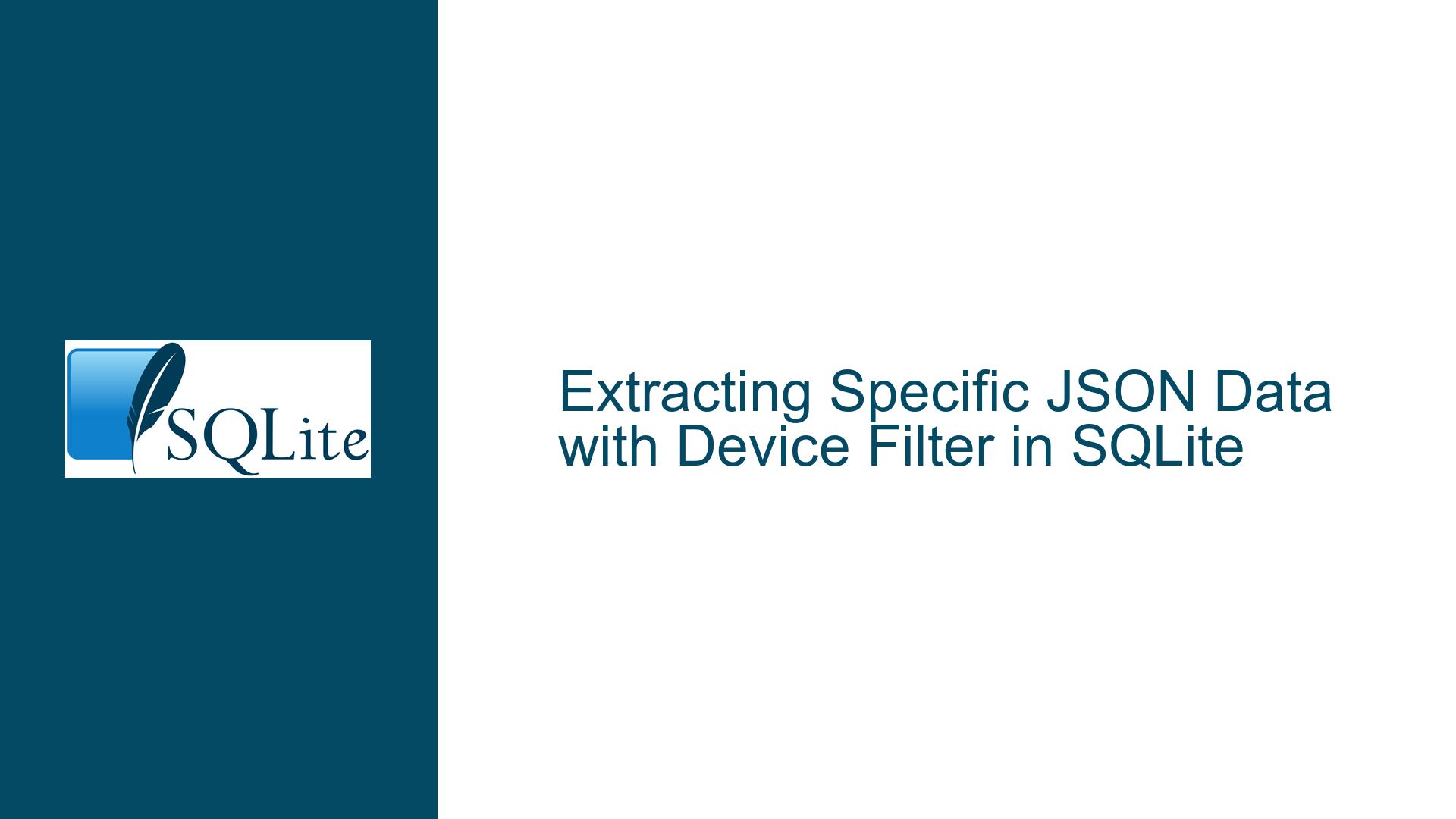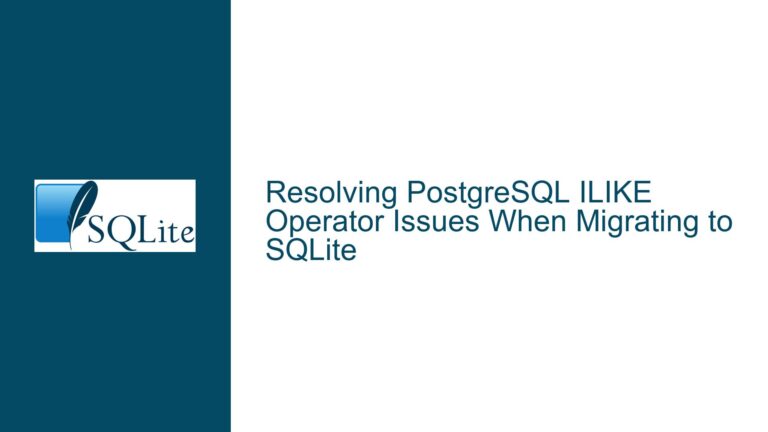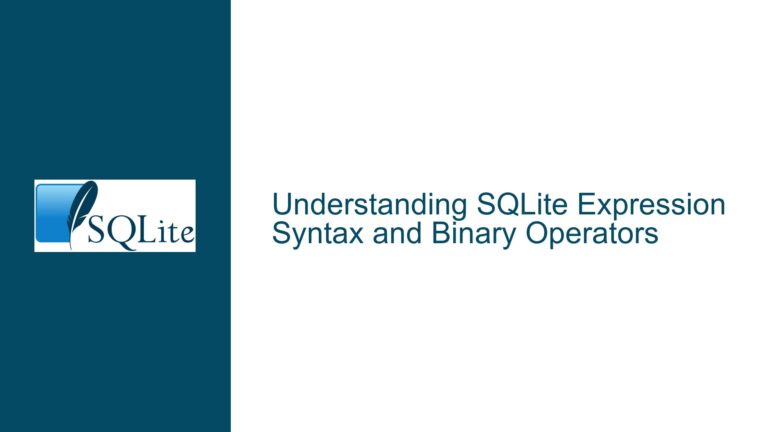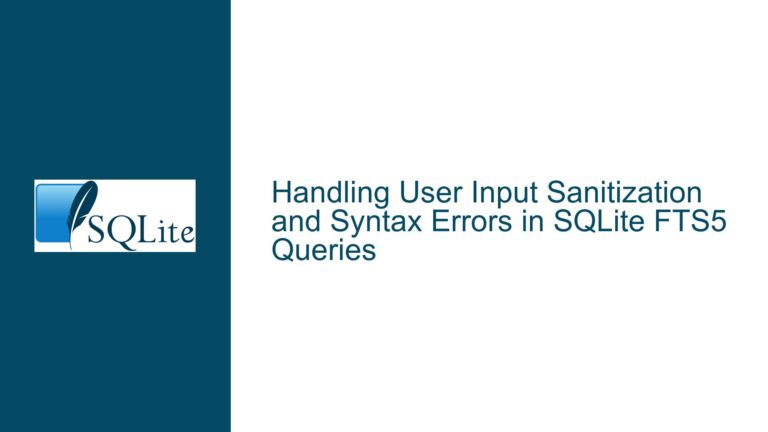Extracting Specific JSON Data with Device Filter in SQLite
Issue Overview: Difficulty Isolating JSON Field by Device in SQLite Queries
The user’s primary challenge revolves around extracting a specific JSON field (meter_reading) from a SQLite database table while filtering results to include only rows where the DEVICE column contains the value IP22. The table structure includes two columns: DEVICE (text) and DATA (text containing JSON objects).
Technical Context
Table Schema:
CREATE TABLE "Energy" ( "DEVICE" TEXT NOT NULL, "DATA" TEXT NOT NULL );DEVICEstores identifiers likeIP22orIP15.DATAstores JSON objects with fields such asmeter_reading,timestamp, and others. Example JSON:{ "cost": 0.6, "iso": "2022-08-31T08:03:28.322Z", "location": "Garage - Electricity", "meter_reading": 1.352, "timestamp": 1661933008, "total_cost": 0 }
Initial Query:
SELECT * FROM Energy WHERE json_extract(Energy.DATA, '$.meter_reading') >= 0;- This returns all rows where
meter_readingis non-negative, regardless of theDEVICEvalue. The user wanted to restrict results toIP22devices only.
- This returns all rows where
Root Problem:
The query lacked a condition to filter rows by theDEVICEcolumn. SQL’sWHEREclause requires explicit conditions for each filtering criterion. Without this, the query returns all rows satisfying the JSON condition, irrespective of theDEVICEvalue.JSON Handling in SQLite:
SQLite’sjson_extractfunction retrieves values from JSON-formatted text. However, combining JSON operations with standard SQL filtering requires careful syntax to avoid logical errors.
Possible Causes: Why the Query Returned Unfiltered Results
1. Missing DEVICE Filter in the WHERE Clause
The original query did not include a condition to restrict results to DEVICE = 'IP22'. SQL processes WHERE clauses by evaluating all conditions; omitting the device filter meant the JSON condition alone determined the result set.
Example of Logical Flow:
Return all rows WHERE [meter_reading >= 0] is true.
No consideration for DEVICE values.
2. Misunderstanding SQL Operator Precedence and Logical AND
When combining multiple conditions, the AND operator must explicitly link them. A common mistake is assuming separate WHERE clauses or omitting AND, leading to unintended results.
Incorrect Approach:
SELECT * FROM Energy
WHERE DEVICE = 'IP22',
json_extract(Energy.DATA, '$.meter_reading') >= 0; -- Syntax error
Correct Approach:
SELECT * FROM Energy
WHERE DEVICE = 'IP22'
AND json_extract(Energy.DATA, '$.meter_reading') >= 0;
3. Incorrect Use of Quotes for String Literals
SQL uses single quotes (') for string literals and double quotes (") for identifiers (e.g., table/column names). Using double quotes for IP22 would cause errors if IP22 were interpreted as an identifier.
Incorrect:
WHERE DEVICE = "IP22" -- Treats IP22 as an identifier (column/table), not a value.
Correct:
WHERE DEVICE = 'IP22' -- Treats IP22 as a string literal.
4. Data Type Mismatch in JSON Extraction
The meter_reading field in the JSON might be stored as text (e.g., "0.0") instead of a numeric type. This could cause unexpected behavior when comparing values (e.g., >= 0). SQLite’s json_extract returns JSON values in their native types, but if stored as text, explicit casting may be required.
Example Issue:
-- If meter_reading is stored as "0.0" (text):
json_extract(DATA, '$.meter_reading') >= 0 -- Returns false due to string comparison.
Troubleshooting Steps, Solutions & Fixes: Refining Queries for Accurate Results
Step 1: Validate Table Structure and Data
Before writing queries, inspect the table schema and sample data to ensure alignment with expectations.
Action:
Retrieve the table schema:
.schema EnergyConfirm
DEVICEandDATAcolumns exist with the correct data types.Sample data check:
SELECT DEVICE, DATA FROM Energy LIMIT 2;Verify that
DEVICEcontainsIP22/IP15andDATAcontains valid JSON.
Step 2: Write a Targeted Query with Combined Conditions
Combine the JSON extraction and device filter using AND.
Solution:
SELECT *
FROM Energy
WHERE DEVICE = 'IP22'
AND json_extract(DATA, '$.meter_reading') >= 0;
Breakdown:
DEVICE = 'IP22'filters rows to the specific device.json_extract(...) >= 0ensures only non-negative meter readings are included.ANDlinks the two conditions, requiring both to be true.
Step 3: Optimize JSON Extraction and Column Selection
To retrieve only the meter_reading and DEVICE, refine the SELECT clause.
Optimized Query:
SELECT
DEVICE,
json_extract(DATA, '$.meter_reading') AS meter_reading
FROM Energy
WHERE DEVICE = 'IP22'
AND meter_reading >= 0;
Key Points:
- Use column aliases (
AS meter_reading) for readability. - SQLite allows referencing aliases in the
WHEREclause if defined inSELECT.
Step 4: Handle Data Type Issues in JSON Fields
If meter_reading is stored as text or inconsistently typed, cast it explicitly.
Casting to Real:
SELECT
DEVICE,
CAST(json_extract(DATA, '$.meter_reading') AS REAL) AS meter_reading
FROM Energy
WHERE DEVICE = 'IP22'
AND meter_reading >= 0;
Why This Works:
CAST(... AS REAL)converts extracted JSON values to floating-point numbers.- Avoids string-vs-number comparison errors (e.g.,
"0.0"vs.0).
Step 5: Debugging Common Errors
Problem: Query Returns No Results Despite Valid Data
- Check Quotes: Ensure
'IP22'uses single quotes. - Verify JSON Paths: Confirm
$.meter_readingmatches the JSON structure. - Data Type Inspection: Use
typeof()to debug JSON extracts:SELECT typeof(json_extract(DATA, '$.meter_reading')) FROM Energy;
Problem: Incorrect Filtering with Combined Conditions
- Test Conditions Separately:
-- Check device filter alone: SELECT * FROM Energy WHERE DEVICE = 'IP22'; -- Check JSON condition alone: SELECT * FROM Energy WHERE json_extract(DATA, '$.meter_reading') >= 0;Ensure both sub-queries return expected results before combining them.
Step 6: Advanced JSON Querying with json_tree
For nested JSON or arrays, use json_tree to flatten structures. However, this was misapplied in the user’s follow-up attempt.
Correct Usage:
SELECT
json_extract(value, '$.meter_reading') AS meter_reading
FROM Energy, json_tree(Energy.DATA)
WHERE DEVICE = 'IP22'
AND json_tree.key = 'meter_reading';
Notes:
json_treegenerates a row for each JSON element. Filter withjson_tree.key = 'meter_reading'to isolate specific fields.- Avoid unnecessary joins if the JSON structure is flat.
Step 7: Integration with External Tools (e.g., Grafana)
To visualize data in Grafana:
- Ensure Correct Data Types: Grafana may misinterpret text-based numbers. Use
CASTin queries. - Time Series Format: Extract ISO timestamps as
datetimefields:SELECT json_extract(DATA, '$.iso') AS time, json_extract(DATA, '$.meter_reading') AS meter_reading FROM Energy WHERE DEVICE = 'IP22'; - Grafana Data Source Configuration:
- Set the
timefield as the timestamp in Grafana’s panel settings. - Use
meter_readingas the metric.
- Set the
Step 8: Schema Design Considerations for Future Projects
Storing JSON in SQLite offers flexibility but complicates querying. Consider normalizing data into separate columns for frequent queries:
Alternative Schema:
CREATE TABLE Energy (
DEVICE TEXT NOT NULL,
meter_reading REAL,
timestamp INTEGER,
location TEXT
);
Benefits:
- Simplified queries without JSON functions.
- Improved performance via indexing on
DEVICEortimestamp.
This guide systematically addresses the core issue of filtering JSON data by device in SQLite, offering both immediate fixes and long-term best practices.






